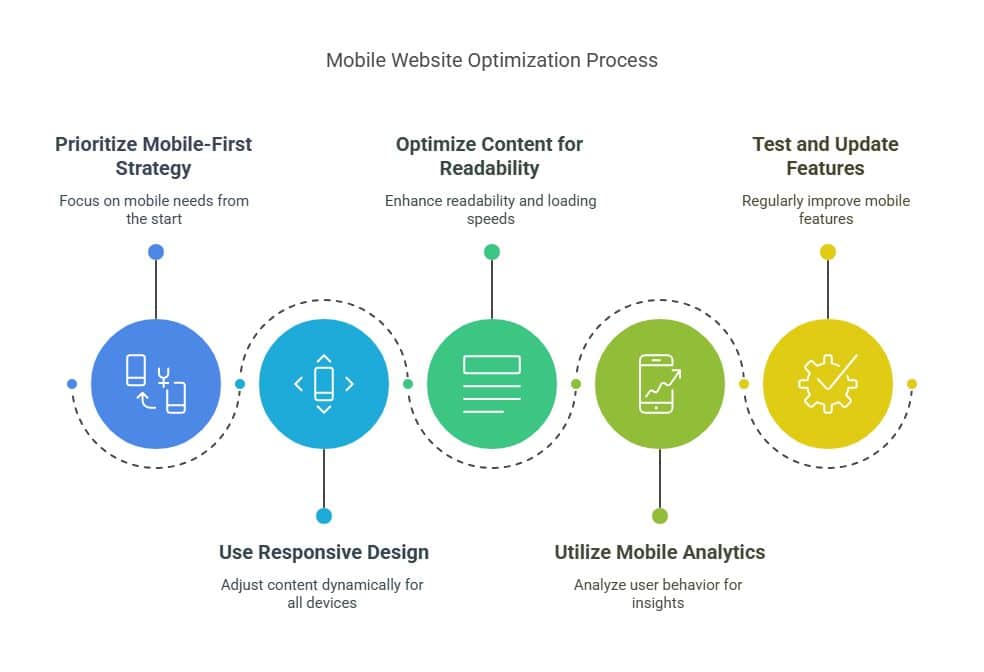
Secrets to Mastering Mobile SEO: A Starter Guide
To truly master mobile SEO, adopting a mobile-first approach is essential, given the growing number of mobile users. Start by implementing responsive design to ensure your site adapts seamlessly to different screen sizes. This includes using responsive typography and touch-friendly navigation to enhance legibility and usability on smaller devices. Boost performance by employing lazy loading for images and optimizing page speed through techniques like AMP (Accelerated Mobile Pages). Create content that is concise and tailored for mobile, integrating local optimization to attract nearby users. Additionally, ensure that all media is responsive and easily accessible on mobile devices. Regular mobile usability testing is vital for identifying and resolving any navigation issues. It’s important to continuously update and refine your strategy to stay aligned with user behavior and technological advancements. By exploring these best mobile SEO practices for beginners, you can unlock comprehensive insights into effective mobile optimization techniques.
Key Takeaways
- To create websites that are optimized for mobile users right from the start, give priority to a mobile-first strategy.
- Use responsive design to ensure that content is accessible on all devices by dynamically adjusting screen size.
- Improve readability and loading speeds by optimizing content with succinct paragraphs and responsive media.
- Make use of mobile analytics to comprehend user behavior and adjust optimization tactics in response to exchanges.
- Test and update mobile features frequently to preserve ongoing enhancements and improve user experience.

Optimize Your Site Mobile-First

Prioritize optimizing your site with a mobile-first approach to ensure it meets the needs of today’s predominantly mobile users. This strategy is fundamental to enhancing user experience and maintaining competitiveness in an ever-evolving digital landscape.
A cornerstone of this approach is responsive design, which ensures your website dynamically adjusts to various screen sizes and orientations. This flexibility not only improves user satisfaction but also signals to search engines that your site is designed with accessibility in mind.
Incorporating touch navigation is another critical aspect. Recognizing the unique interaction patterns of mobile users, such as swiping and tapping, can significantly enhance the usability of your site. Designing intuitive touch navigation elements allows users to seamlessly interact with your content, reducing friction and encouraging longer site visits.
Mobile analytics play a pivotal role in understanding user behavior on your mobile site. By analyzing metrics specific to mobile users, such as bounce rates and session durations, you can identify areas for improvement and tailor your content and design to better meet user expectations.
This data-driven approach ensures that your site continually evolves to serve its audience effectively.
Additionally, AMP implementation can significantly boost loading times, which is crucial given that mobile users often demand quick access to information. Accelerated Mobile Pages (AMP) provide a streamlined version of your web content, ensuring faster load speeds and enhancing user experience.
Prioritizing these elements in your mobile-first strategy will not only improve user engagement but also bolster your site’s performance in mobile search rankings.
Check If Your Site Is Mobile-Friendly
Ensuring that your site is mobile-friendly is a fundamental step in the mobile-first approach discussed previously. This involves assessing how effectively your site adapts to various mobile devices and screen sizes. A responsive design is critical, automatically adjusting the layout and elements of your website to provide an optimal viewing experience across different devices. This adaptability not only enhances the user experience but also positively impacts your search engine rankings.
To begin, evaluate your site’s responsiveness using online tools that simulate different screen sizes. These tools can highlight areas that may need adjustment to improve usability on mobile devices.
Additionally, consider the nuances of touch interactions. Elements such as buttons and links should be sized and spaced appropriately to accommodate finger taps, preventing user frustration and enhancing navigation.
Incorporating mobile analytics into your strategy is crucial. These analytics provide insights into how mobile users interact with your site, revealing patterns and potential issues that could hinder performance. This data-driven approach allows for informed decisions to refine your mobile strategy continually.
Another aspect to consider is voice search. With the increasing use of digital assistants, optimizing for voice search is becoming essential. Ensure your content is conversational and answers specific questions your target audience might ask aloud.
Page Speed Optimization

Page speed optimization is a critical component of mobile SEO, as it directly influences user engagement and search engine rankings. In today’s fast-paced digital landscape, users demand immediate access to information, making speed a pivotal factor in retaining their attention. Responsive design techniques are essential for ensuring that sites load efficiently across various devices. These techniques adapt layouts to fit different screen sizes, reducing load times and enhancing user experience.
AMP implementation strategies (Accelerated Mobile Pages) provide another method for speeding up mobile page delivery. By stripping down HTML and utilizing streamlined CSS, AMP ensures that content loads almost instantaneously. This can significantly boost a site’s performance in search results, aligning with user expectations and search engine algorithms focused on speed.
Furthermore, leveraging mobile analytics tools can aid in pinpointing elements that slow down site performance. These tools offer insights into user interactions, identifying bottlenecks in the loading process. Improvements can then be made to enhance user experience and optimize local SEO tactics, ensuring that mobile users find relevant information swiftly in their immediate vicinity.
Below is a table illustrating key aspects of page speed optimization:
| Aspect | Description | Benefit |
| Responsive Design | Adjusts layout for various devices | Improved load times |
| AMP Implementation | Streamlined HTML and CSS for faster loading | Higher search rankings |
| Mobile Analytics Tools | Analyzes site performance and user interaction | Identifies speed bottlenecks |
Mobile-Friendly Content
Having optimized page speed, the focus now shifts to the creation of mobile-friendly content, an indispensable element of effective mobile SEO. Crafting content that seamlessly adapts to various devices requires employing responsive design techniques. These techniques ensure that text, images, and layouts adjust dynamically to fit different screen sizes, enhancing the mobile user experience.
An optimal mobile experience is crucial, as it directly influences how users interact with your site, ultimately affecting your search engine rankings.
Content formatting strategies play a vital role in mobile-friendly design. Short paragraphs, bullet points, and concise headlines improve readability on smaller screens, allowing users to digest information swiftly. Additionally, using larger fonts and enough spacing between elements prevents accidental clicks and reduces frustration.
Touch friendly navigation is another cornerstone of mobile-friendly content. Menus and buttons should be designed for easy access with fingers, ensuring smooth navigation. This can be achieved by increasing the size of clickable elements and spacing them adequately to avoid overlapping.
Simplified navigation enhances user satisfaction and encourages longer site visits, positively impacting your site’s SEO.
Incorporating local search impact into your mobile content strategy is also beneficial. Mobile users often conduct location-based searches, seeking nearby services or information. Optimizing content with location-specific keywords can increase visibility in local search results, driving more targeted traffic to your site.
Image and Video Optimization

Optimizing images and videos for mobile devices is crucial to improving site performance and enhancing user experience. As mobile users continue to outnumber desktop users, ensuring that your media content is optimized for these devices becomes indispensable.
Responsive images and videos are the foundation of this process, automatically adjusting their size based on the user’s device. This ensures that they load quickly and display correctly, contributing to a seamless browsing experience.
Here are three strategies to evoke emotion and inspire action in your optimization efforts:
- Empathy for Users: Understand that users may be on limited data plans or slower connections. Implementing video compression and using mobile formats like WebP and MP4 can significantly reduce loading times and data usage, fostering a considerate experience.
- Accessibility and Inclusivity: Alt text is more than just an SEO tool; it’s a bridge of accessibility for visually impaired users. Employ descriptive alt texts to convey the context of images and videos, ensuring that everyone can engage with your content.
- Patience and Anticipation: Lazy loading is a technique that defers the loading of non-essential images and videos until they are needed. This not only speeds up initial page load times but also creates a sense of anticipation for users as they scroll through your site.
Mobile Usability Testing

As images and videos form the visual backbone of a mobile website, ensuring their optimization is only the first step in creating a user-friendly experience. Mobile usability testing is crucial for identifying areas where a site’s functionality may hinder user interactions. This process involves evaluating several key elements, such as mobile navigation design, which ensures users can effortlessly find their way around a site. A well-structured navigation system is intuitive and minimizes the number of steps users must take to reach their desired destination.
Touch target sizing is another critical aspect of usability testing. Inadequately sized touch targets can lead to user frustration, as they may accidentally click on the wrong links or buttons. Ensuring that touch targets are large enough for fingers to interact comfortably is essential for a seamless user experience. This fosters a more accessible mobile environment, aligning with mobile accessibility standards that aim to make web content more inclusive for all users.
Responsive typography plays a vital role in readability across various devices. Fonts should automatically adjust to different screen sizes to maintain legibility without requiring users to zoom in. This adaptability enhances the overall user experience, as content remains clear and easy to read on any device.
Conducting comprehensive user experience testing helps identify potential pain points and allows businesses to refine their mobile strategies. By focusing on these elements, companies can create a more engaging and efficient mobile experience, ultimately leading to higher user satisfaction and increased retention.
Through systematic testing and adjustments, mobile usability can be significantly enhanced, paving the way for successful mobile SEO outcomes.
Final Thoughts
Mastering mobile SEO is essential in today’s digital landscape, especially as mobile usage continues to surge. By focusing on key strategies such as optimizing for mobile speed, implementing responsive design, simplifying navigation, and enhancing mobile content, you can significantly improve user experience and search engine rankings. Additionally, prioritizing image and video optimization, as well as conducting regular mobile usability testing, will help ensure that your site remains user-friendly and accessible across all devices. By applying these best practices, you will not only attract more visitors but also foster greater engagement and retention.
Looking to elevate your website’s mobile SEO performance? Connect with Syville Gacutan, an experienced SEO Specialist in the Philippines. With a proven track record in mobile optimization, technical SEO, and search visibility enhancement, Syville can help your business achieve lasting digital success. Contact Syville today and start transforming your online presence.